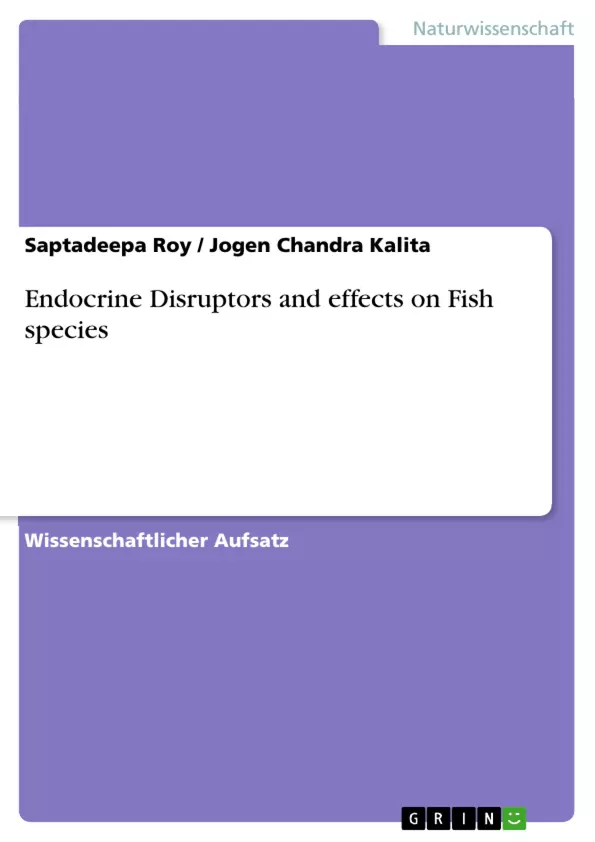Abstract:
Certain chemicals including industrial intermediates, PAHs, PCBs, pesticides, dioxins, trace elements and plant sterols has the capability to interfere with the endocrine system in fish. The potency of most of these chemicals, however, is typically hundreds to thousands of times less than that of endogenous hormones. Evidence of environmental endocrine disruption in fishes ranges from the presence of female egg proteins in males and reduced levels of endogenous hormones in both males and females, to gonadal histopathologies and intersex (presence of ovotestes) fish.
Abstract:
Certain chemicals including industrial intermediates, PAHs, PCBs, pesticides, dioxins, trace elements and plant sterols has the capability to interfere with the endocrine system in fish. The potency of most of these chemicals, however, is typically hundreds to thousands of times less than that of endogenous hormones. Evidence of environmental endocrine disruption in fishes ranges from the presence of female egg proteins in males and reduced levels of endogenous hormones in both males and females, to gonadal histopathologies and intersex (presence of ovotestes) fish.
Keywords: Estrogen Receptor, Vitellogenin, EDCs, Ovotestis
Introduction
The presence and effects of EDCs is not a new phenomenon. As early as 1949, it was known that crop dusters handling dichlorodiphenyltrichloroethane (DDT) frequently had reduced sperm counts (Patlak, 1996). DDT was shown to produce characteristically estrogenic responses in the reproductive tracts of rats and birds (Bitman and Cecil, 1970). The tragic use of the synthetic estrogen diethylstilbestrol, or DES, by pregnant women from the late 1940s until 1971 to help prevent miscarriages resulted in infertility and increased rates of vaginal clear cell adenocarcinomas in daughters (Colborn et al., 1993).
Fish as models for evaluating EDC.
EDCs are commonly present in the aquatic environments in combination with each other together with many other differently acting substances. Fish are a group of animals most at threat from aquatic pollution and with their physiological similarity to mammals including humans (Kime, 1998). Many of the investigations into EDCs in the aquatic environment have involved fish because of similarities in the endocrine system to higher vertebrates (Bond, 1979) . Fish are vertebrates and therefore have a close evolutionary relationship to mammals. Thus, mechanisms discovered in fish are more likely to be relevant to humans.
Structural similarities of EDCs with endogenous hormones
Frequently asked questions
What is the main topic discussed in this document?
The document primarily discusses endocrine-disrupting chemicals (EDCs) and their impact on fish, including their mechanisms of action and potential effects.
What are some examples of EDCs mentioned in the text?
The document mentions industrial intermediates, PAHs, PCBs, pesticides, dioxins, trace elements, plant sterols, and specifically names DDT and diethylstilbestrol (DES) as examples of EDCs.
How do EDCs affect fish?
EDCs can interfere with the endocrine system in fish, leading to effects such as the presence of female egg proteins in males, reduced levels of endogenous hormones, gonadal histopathologies, and intersex characteristics (presence of ovotestes).
Why are fish used as models for studying EDCs?
Fish are used as models because they are commonly exposed to EDCs in aquatic environments, and their endocrine systems share similarities with those of higher vertebrates, including humans. This makes findings in fish more likely to be relevant to human health.
What is the structural similarity of EDCs with endogenous hormones, and why is it significant?
EDCs often possess structural similarities to endogenous estrogenic and androgenic hormones. This structural resemblance allows them to interact with hormone transport proteins and disrupt hormone metabolism, enabling them to mimic or block the effects of the body's natural hormones.
What are some keywords associated with this topic?
Keywords associated with this topic include Estrogen Receptor, Vitellogenin, EDCs, and Ovotestis.
- Quote paper
- Saptadeepa Roy (Author), Jogen Chandra Kalita (Author), 2011, Endocrine Disruptors and effects on Fish species, Munich, GRIN Verlag, https://www.hausarbeiten.de/document/177627


